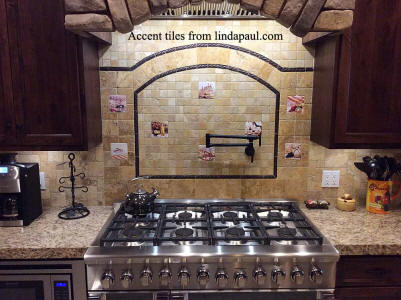When it comes to home decor, the details truly matter. One such detail that can elevate any room from ordinary to extraordinary is the use of decorative accent tiles. I’ve spent hours perusing tile stores, hunting for the perfect pieces to bring my home to life, and let me tell you, the right accent tile can convert a dull wall into a stunning focal point.
The Allure of Decorative Accent Tiles
Decorative accent tiles are more than just functional; they’re a way to express personal style. They can add color, texture, and unique designs to your home, whether you’re aiming for a rustic, modern, or eclectic look. In this article, we’ll explore various aspects of decorative accent tiles, from their styles to installation tips, and much more.
What Are Decorative Accent Tiles?
Decorative accent tiles are typically smaller tiles used to create a visual contrast or a decorative element within a larger tile scheme. They can be made from materials like ceramic, glass, stone, or even metal, and are often used for backsplashes, feature walls, and flooring.
Styles of Decorative Accent Tiles
There is a plethora of styles available when it comes to accent tiles. Here are some of the most popular:
1. Subway Tiles
Subway tiles are a timeless choice, often used in kitchens and bathrooms. Their clean lines and classic look make them versatile for various design aesthetics.
2. Mosaic Tiles
Mosaic tiles come in an array of colors and patterns, allowing for creative expression. They can be used as a border or even as a full accent wall.
3. Geometric Tiles
Geometric tiles add a modern touch, featuring sharp lines and angles. They can bring a contemporary feel to traditional spaces.
4. Textured Tiles
Textured tiles offer depth and interest. These tiles can be used to accentuate certain areas, such as a fireplace or kitchen island.
Choosing the Right Decorative Accent Tile
Choosing the right tile can be daunting due to the multitude of options available. Here are a few factors to consider:
1. Material
Think about where the tile will be placed. For wet areas, ceramic or porcelain tiles might be best, while glass tiles could enhance a decorative feature.
2. Color Scheme
Make sure your decorative accent tiles fit into your overall color scheme. They should complement other elements in the room, whether they stand out or blend in.
3. Size and Scale
Consider the size of the area you’re tiling. Larger tiles can make a small space feel bigger, while smaller tiles can add intricate detail to larger areas.

Installation of Decorative Accent Tiles
Installing decorative accent tiles can be a DIY project or something to hire a professional for. Based on my personal experience, I recommend taking on the project yourself if you’re feeling adventurous. Here’s a simplified breakdown of the installation process:
Tools Required for Tile Installation
- Trowel
- Tile cutter
- Level
- Grout float
- Sponges
Step-by-Step Installation Process
- Preparation: Ensure the surface is clean and dry.
- Layout: Plan your layout and mark guidelines on the wall or floor.
- Adhesive: Apply tile adhesive with a trowel.
- Placing Tiles: Begin placing the decorative tiles, using spacers for even gaps.
- Grouting: Once the adhesive sets, apply grout and clean the excess.
- Sealing: Depending on the type of tile, sealing may be necessary.

Common Challenges and Solutions
| Challenge | Solution |
|---|---|
| Uneven Surface | Use a leveling compound before installation. |
| Cutting Tiles | Invest in a quality tile cutter for clean cuts. |
| Grout Haze | Use a damp sponge to wipe away residue before it dries. |
Maintaining Decorative Accent Tiles
Once installed, it’s essential to maintain your decorative accent tiles to keep them looking new. Here are some tips based on my personal experience:
Cleaning Tips
- Use a pH-neutral cleaner for regular maintenance.
- Avoid abrasive pads which can scratch tile surfaces.
- Wipe spills immediately to prevent stains, especially with porous materials.

Sealing Tiles
Some tiles may require sealing to protect them from moisture and stains. Be sure to follow the manufacturer’s instructions for sealing frequency.
Pros and Cons of Decorative Accent Tiles
| Pros | Cons |
|---|---|
| Adds unique character to spaces | Can be more expensive than regular tiles |
| Variety of styles and materials | Installation can be labor-intensive |
| Easy to clean and maintain | Some materials may require sealing |

Trendy Ideas for Using Decorative Accent Tiles
Ready to take the plunge? Here are some trendy ideas for using decorative accent tiles in your home:
Kitchen Backsplashes
A decorative tile backsplash can become the centerpiece of your kitchen, adding color and texture above your countertops.
Bathroom Showers
In the shower, decorative tiles can create a stunning focal point while adding safety with textured options.

Fireplace Surrounds
Consider using intricate tiles around your fireplace to create a cozy and sophisticated atmosphere.
Accent Walls
A single wall adorned with decorative accent tiles can change the entire vibe of a room, providing a striking contrast to the surrounding paint or wallpaper.

Frequently Asked Questions
What are the best materials for decorative accent tiles?
The best materials often depend on the location and function. Ceramic and porcelain are durable for wet areas, while glass tiles can provide a sleek, modern look.
How do I choose the right size for accent tiles?
Consider the scale of your space. Larger tiles can make small areas feel bigger, while smaller tiles are great for intricate designs and patterns.

Are decorative accent tiles easy to install?
While installing tiles can be labor-intensive, many homeowners find it manageable with the right tools and guidance. However, hiring a professional is always an option if you’re unsure.
Can I use decorative accent tiles outdoors?
Yes, many decorative tiles are suitable for outdoor use. Just ensure they are rated for outdoor applications and can withstand temperature changes.